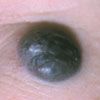Cellular Blue Nevus Next to Eye and Basal Cell Carcinoma on Shin
A Photo Quiz to Hone Dermatologic Skills

Case 1:
A 19-year-old woman has had a blue-black nodule next to her left eye since birth. After recent accidental trauma, the lesion has enlarged. What is your clinical impression?
A. Nevus of Ota.
B. Cellular blue nevus.
C. Combined nevus.
D. Spitz nevus.
E. Melanoma.
Bonus question: Why does this pigmented lesion appear grayish blue-black rather than brown or black?
(Answers on next page.)

Case 1: Cellular blue nevus
Biopsy results confirmed a benign cellular blue nevus, B. These nevi are evenly colored gray, bluish, or black and have symmetrical, smooth borders. Congenital or acquired, single or multiple blue nevi can arise at any location; however, they more often occur on the buttocks than on the face. These lesions are more common in women than in men. Although they are benign, blue nevi occasionally can become invasive.
A nevus of Ota is a gray or bluish macule that involves the eye. Combined nevi generally possess features of blue nevi and of compound nevi, with one of the lesions layered atop the other. These usually thicker nevi are typically darker brown to black, symmetrical, and have smooth borders; they can be found anywhere on the body. Spitz nevi usually are pink, brownish red, or purplish red lesions of less than 10 mm. Melanoma is always a concern; this patient's nevus resembled a nodular variant of skin cancer. The biopsy ruled out a malignancy.
Answer to the bonus question: The grayish blue-black color is attributed to bending light rays; dermal melanin from dermal melanocytes is brown on the surface of the skin but appears to be gray or blue when below the surface.

Case 2:
Twenty years after an asymptomatic growth erupted on his shin, a 77-year-old man seeks medical evaluation of the slowly enlarging lesion. What do you suspect?
A. Seborrheic keratosis.
B. Basal cell carcinoma.
C. Melanoma.
D. Venous angioma.
E. Blue nevus.
Which course of action do you pursue?
F. Perform a shave biopsy.
G. Perform a punch biopsy.
H. Perform an incisional biopsy.
I. Perform an excisional biopsy.
J. Offer reassurance.
(Answers on next page.)

Case 2: Basal cell carcinoma
The lesion's pigmentation and general appearance suggested a possible skin cancer. A punch biopsy, G, confirmed the diagnosis of basal cell carcinoma, B. Because of the possibility of melanoma, the biopsy specimen needs to include the base of the tumor; therefore, incisional biopsy, H, and excisional biopsy, I, are appropriate as well. A deep shave biopsy, F, may be adequate. A bluish lesion is not typical of seborrheic keratoses. The appearance of venous angiomas can be deceptive, but they usually look more vascular than this lesion. Blue nevi may be nodular; rarely, they undergo malignant degeneration.
This basal cell carcinoma-the only such lesion on this patient-was surgically removed without complications.

Case 3:
The parents of a 4-year-old boy are concerned about the linear, grouped, pigmented, flat papules on their child's upper back. The lesions have been present for a few months. Do you recognize this eruption?
A. Common warts.
B. Linear epidermal nevi.
C. Lichen striatus.
D. Seborrheic keratoses.
E. Lichen planus.
(Answer on next page.)

Case 3: Linear epidermal nevi
These verrucous-like lesions may be present at birth or can arise at any time before age 10 years. They may be unilateral or bilateral and can vary in color. There is no risk of malignant transformation. No treatment is necessary; surgery may be performed to remove the lesions for cosmesis.
Inflammatory linear verrucous epidermal nevi (ILVEN) is an erythematous and pruritic variant of this disorder. The linear epidermal nevus syndrome, described by Solomon and colleagues1 in 1968, is associated with CNS, cardiovascular, skeletal, and ophthalmic abnormalities. Other skin lesions occur in this syndrome as well; they include hemangiomas; pigmentary changes; and cutaneous malignancies, such as basal cell and squamous cell carcinomas.
An extensive workup is warranted for patients with epidermal nevi who fail to meet developmental milestones and/or have systemic abnormalities. However, most persons with these lesions, such as this patient, do not have associated syndromes.
Common warts are flesh-colored and characterized by reddish brown dots on a vegetated surface. They arise on sites of trauma; knees, fingers, and hands are frequent locations. Lichen striatus is a self-limited, asymptomatic eruption that usually extends distally on one limb and spontaneously clears in 1 to 2 years. Seborrheic keratoses are scattered and discrete and rarely occur in persons younger than age 30 years. Lichen planus lesions may manifest in a linear pattern (Koebner phenomenon); however, it is unlikely for this condition to develop in a young child and as an isolated group of lesions.
REFERENCE:
1. Solomon LM, Fretzin DF, Dewald RL. The epidermal nevus syndrome. Arch Dermatol. 1968;97:273-285.

Case 4:
A highly pruritic patch has been present for almost a year on the back of a 19-year-old woman's scalp. Over-the-counter medicated shampoos have had no effect. The patient reports that the 2 elevated, erythematous plaques on her right posterior scalp are the only such lesions on her body. She takes no medications.
What does this look like to you?
A. Seborrhea.
B. Sebopsoriasis.
C. Contact dermatitis to shampoo or conditioner.
D. Prurigo nodularis.
E. Tinea capitis.
(Answer on next page.)

Case 4: Prurigo nodularis
A skin biopsy confirmed the suspected diagnosis of prurigo nodularis, D, a condition caused by chronic scratching. Academic pressures caused the patient to habitually scratch the back of her head and neck.
She was urged to seek counseling to learn stress management techniques. A topical corticosteroid was prescribed for symptom relief. Intralesional corticosteroid therapy may be required for recalcitrant prurigo nodularis.
Seborrhea or sebopsoriasis may be an underlying cause of a highly pruritic posterior scalp; however, these disorders typically feature more scale and more generalized eruptions. Contact dermatitis caused by hair care products usually presents as a diffuse scaly eruption along the hairline.